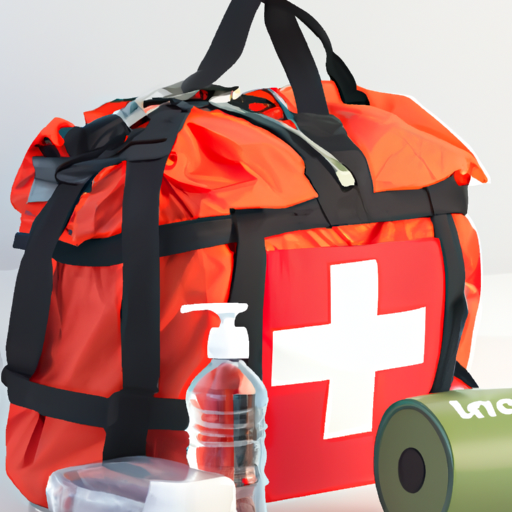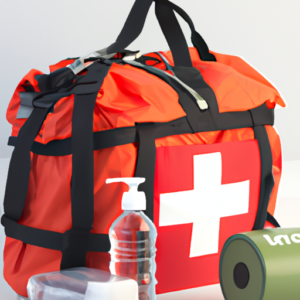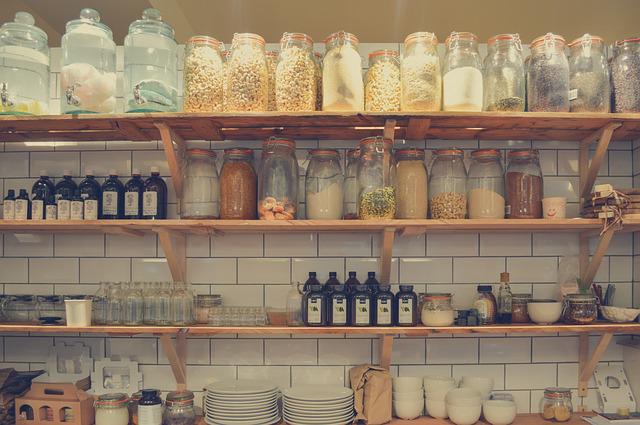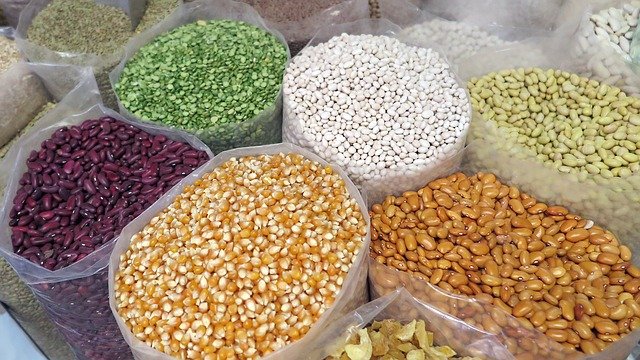
by Preparation | Sep 16, 2023 | Preparation Guide, Preparation Supplies, Preparedness
Imagine being stranded in the middle of nowhere, with no immediate help in sight. Sounds scary, right? Now, imagine having a bug-out bag in your car, equipped with all the essentials to survive such a situation. Suddenly, the scenario seems less daunting.
Creating a bug-out bag for your car is a simple yet crucial task that can be a lifesaver in emergencies. This guide will provide you with a comprehensive step-by-step process to prepare your own bug-out bag.
From selecting the right bag to choosing essential items, we’ll cover all bases to ensure your survival kit is up to the task. So, buckle up and get ready to dive into the world of emergency preparedness, where safety is just a well-packed bag away.
What is a bug-out bag?
A bug-out bag, also known as a 72-hour kit, is a portable pack containing all the essentials needed to survive for at least three days in case of an emergency. It’s a crucial part of any emergency preparedness plan, especially for those who frequently travel by car.
The contents of a bug-out bag can vary depending on individual needs, but typically include items such as:
- Food and Water: Non-perishable food items and water purification tablets or filters.
- First Aid Kit: Bandages, antiseptics, pain relievers, and any necessary prescription medications.
- Shelter and Warmth: Emergency blanket, poncho, and a compact sleeping bag.
Other items might include a multi-tool, flashlight, portable charger, local maps, and cash. Remember, the goal is to equip yourself with the necessary tools to manage in the face of a disaster.
Creating a bug-out bag for your car ensures you’re always prepared, whether you’re on a routine commute or embarking on a long road trip. It’s not just about surviving, but thriving during unexpected situations. The key is to tailor your bug-out bag to your specific needs and circumstances, ensuring it’s lightweight yet comprehensive. This way, you’re always ready to bug-out when the situation calls for it.
Why should I have a bug-out bag in my car?
Having a bug-out bag in your car is a practical measure for unexpected situations. It serves as your survival kit, equipped with necessities that can sustain you for at least 72 hours. Imagine being stranded due to a car breakdown or natural disaster. A bug-out bag would come in handy, providing essential items like food, water, first-aid supplies, and tools for repair or navigation.
Moreover, a bug-out bag can be a literal lifesaver during emergency evacuations. In situations where you need to leave your home immediately, you may not have time to gather supplies. Having a bug-out bag in your car ensures you have immediate access to survival essentials.
Creating a bug-out bag for your car, however, requires careful planning. It’s crucial to pack items that are compact, lightweight, and serve multiple purposes.
- Food and Water: Non-perishable food items and water purification tablets can be a lifesaver.
- First-Aid Supplies: A basic kit should include bandages, antiseptic wipes, tweezers, medical tape, and pain relievers.
- Tools: Include a multi-tool, flashlight, batteries, and a fire starter.
Remember, a bug-out bag is not a one-size-fits-all solution. Customize it based on your personal needs and the specific conditions of your region.
What items are essential for a car bug-out bag?
When it comes to emergency preparedness, a car bug-out bag is an essential tool. For a comprehensive bug-out bag, several items are crucial. First, water and food are vital, specifically non-perishable items and water purification tablets.
Next, you’ll need a first-aid kit. This should include bandages, antiseptic wipes, tweezers, medical tape, and pain relievers.
Another critical item is a multi-tool. This versatile tool can serve multiple purposes, from opening cans to cutting rope. Speaking of rope, a paracord is another must-have. It is useful for tying items together, creating shelter, or even for first aid purposes.
- Emergency blanket
- Flashlight
- Extra batteries
These three items can provide warmth, light, and power in challenging situations.
Maps and a compass are also essential for navigation, especially if you’re in an unfamiliar area or if your phone’s battery dies.
Lastly, personal items such as medications, cash, and important documents should also be included in your bug-out bag. These items can help you in various scenarios, whether you need to buy supplies, prove your identity, or manage health conditions.
Remember, the goal is to be prepared for any situation. Each item in your car bug-out bag serves a specific purpose and can be a lifesaver in an emergency.
How to pack a bug-out bag efficiently?
Packing a bug-out bag for your car requires careful consideration and strategic planning. The first step involves identifying essential items that meet your survival needs. Water, non-perishable food, first aid kit, multi-tool, flashlight, and blankets are some of the essentials you should never skip.
Prioritize items based on their importance and pack them accordingly. Water and food should be easily accessible as they are needed frequently. Use vacuum-sealed bags to save space and keep items organized.
The size of your bug-out bag also matters. It should be compact enough to fit in your car but spacious enough to accommodate all necessary items.
Regularly check and update your bug-out bag. Replace expired food and water, and ensure all equipment is in good working condition.
Personalize your bug-out bag based on specific needs. If you have a medical condition, ensure you pack necessary medications.
Here’s a quick checklist to help you pack efficiently:
- Water
- Non-perishable food
- First Aid Kit
- Multi-tool
- Flashlight
- Blankets
Remember, the goal is to be prepared for any emergency. So, pack wisely and stay ready.
Can I use any bag for my bug-out bag?
In the context of creating a bug-out bag for your car, it’s crucial to understand that not just any bag will suffice. The bag you choose must be durable, spacious, and easy to carry. A backpack is often the preferred choice for many, given its practicality and convenience.
It’s also essential that the bag is made of high-quality, rugged material that can withstand harsh conditions. Look for bags with multiple compartments for better organization of your emergency supplies.
- Water-resistant properties are a significant feature to consider. This ensures your supplies stay dry, even in adverse weather conditions.
The size of the bag is another critical factor. It should be big enough to hold necessary items like food, water, first aid kit, clothing, and other essential survival gear, but not so large that it becomes cumbersome to transport.
Comfort should not be overlooked. A bag with padded straps and back support can make a significant difference, especially if you need to carry it for extended periods.
Remember, the goal is to have a bug-out bag that’s ready to grab and go in case of an emergency. Therefore, your choice of bag plays a pivotal role in your preparedness strategy.
How often should I update my car bug-out bag?
Regular updating of your car bug-out bag is crucial to ensure its effectiveness in case of emergencies. The frequency of updates typically depends on the items within your bag. For instance, perishable items like food and water should be replaced every six months. On the other hand, items such as first aid kits and emergency blankets may not require frequent updates, unless used or damaged.
Seasonal changes also warrant updates to your bug-out bag. For example, you might need to add extra warm clothes during winter or include sun protection items in summer.
It’s also a good practice to check and update your bag whenever you perform routine car maintenance. This way, you can ensure that all items are in good condition and ready for use when needed.
Here’s a quick guide on when to update certain items:
- Food and Water: Every six months
- Medications: As per expiry dates
- Seasonal items: At the change of each season
- Other items: During routine car maintenance
Remember, a well-maintained bug-out bag can be a lifesaver during unexpected situations. Regular updates ensure that your bag is always equipped with the necessary items, making your car a reliable refuge in emergencies.
What food should I pack in my bug-out bag?
When preparing your bug-out bag for your car, it’s crucial to consider the types of food that will provide sustenance and long-lasting energy. Non-perishable items are the best choice for a bug-out bag. These include canned goods, such as tuna, beans, and vegetables. However, remember to pack a can opener if necessary!
Dried foods are also excellent options, including jerky, dried fruits, and nuts. These provide a good source of protein and healthy fats. Similarly, energy bars, granola bars, and protein bars are compact and nutrient-dense.
Consider packing ready-to-eat meals (MREs). These are a staple in military rations and are designed to be lightweight, compact, and long-lasting. They offer a variety of meals, from pasta to stew, and only require water to prepare.
Don’t forget about hydration. Pack bottles of water, but also include water purification tablets or a LifeStraw for emergencies.
Instant coffee or tea bags can be a morale booster in stressful situations.
Lastly, remember to rotate your food stocks regularly to ensure they remain fresh and safe to eat. This way, you’ll be ready for any situation with a well-prepared bug-out bag in your car. Remember, the key is to prioritize long-lasting, nutrient-dense foods that require minimal preparation.
Are there ready-made car bug-out bags available?
Absolutely, there are numerous ready-made car bug-out bags available on the market. These bags come packed with essential survival items that you may need in case of an emergency. They are an excellent choice for those who prefer convenience or lack the time to assemble a bag themselves.
When choosing a ready-made bag, you should consider the quality of the items included, the bag’s durability, and whether it contains all the necessities you may need in a crisis. Some of the essential items to look for include:
– First Aid Kit
– Food and Water
– Warm Clothing
– Tools and Equipment
– Communication Devices
It’s crucial to note that while these bags are convenient, they may not be tailored to your specific needs. For instance, you may require specific medication or have dietary restrictions that ready-made bags do not consider.
Therefore, while ready-made car bug-out bags can be a good starting point, you might still need to customize them to suit your unique needs. Remember, the key to a successful bug-out bag is preparation and personalization.
Wrapping Up: How to Create a Bug-Out Bag for Your Car
In conclusion, the importance of having a bug-out bag in your car cannot be underestimated. This article has covered essential topics such as understanding what a bug-out bag is, why it’s necessary to have one in your car, and the crucial items required for an efficient car bug-out bag.
Packing a bug-out bag requires careful selection of items, and not just any bag can be used for this purpose. Regular updates to your bug-out bag are necessary to ensure its contents are always fresh and usable. The food packed should be non-perishable and easy to consume. For those not inclined to DIY, ready-made car bug-out bags are available.
The key takeaway is that a well-prepared bug-out bag can be a lifesaver in emergency situations. As the future unfolds, it’s likely that advancements in survival gear and emergency preparedness will continue to influence the contents and efficiency of bug-out bags. Therefore, it’s essential to stay informed and regularly update your knowledge on the subject. Remember, preparedness is not a one-time event, but a continuous process.

by Preparation | Apr 6, 2023 | Preparation Supplies, Preparedness
Do you Need a Bug-Out Bag in Your Car?
When it comes to emergency preparedness, having a bug-out bag is a no-brainer. This is a pre-packed bag filled with essential items that you will need in case of an emergency evacuation or unexpected emergency situation. While many people prepare for emergencies by having a bug-out bag at home, it’s equally important to have one in your car. Here are a few reasons why:
Emergencies can happen anywhere, anytime
 It’s never possible to predict when and where an emergency will occur. The same is true for natural disasters like earthquakes, hurricanes, floods, and wildfires, which could happen anywhere and anytime. When you’re on the road, you may not have the luxury of time to pack or run back home to grab your bug-out bag. Having a well-prepared go-bag in your car can make all the difference in an emergency.
It’s never possible to predict when and where an emergency will occur. The same is true for natural disasters like earthquakes, hurricanes, floods, and wildfires, which could happen anywhere and anytime. When you’re on the road, you may not have the luxury of time to pack or run back home to grab your bug-out bag. Having a well-prepared go-bag in your car can make all the difference in an emergency.
Your car is one of the best places to store critical survival gear
When it comes to transportation during emergencies, your car can be a reliable means of getting away from a dangerous situation quickly. However, it’s worth noting that your vehicle can also be your shelter and your storage in case of a sudden emergency. Your vehicle can store several survival essentials, including food, water, blankets, spare clothes, and other essential items that can keep you safe and comfortable for a few days.
You’ll be ready for any situation
It’s common knowledge that emergencies come in different forms and magnitudes. Nobody knows what the future holds, and being prepared for anything can help you stay calm and composed during emergencies. In case of a sudden emergency, you won’t be forced to gather everything from scratch; instead, you’ll have what you need in one place. With a well-stocked and organized bug-out bag, you and your family are ready for anything that comes your way.
You can help others in need
When you’re the only person who’s prepared in an emergency situation, you can help others who aren’t as prepared. A well-stocked bug-out bag for your car ensures that you have extra resources like water, first aid kits, and other essentials that you can share with others who may need them. In case of an emergency, you can be the hero who helps others in need.
Conclusion
Emergencies can happen anywhere, anytime, and it’s always better to be prepared than not. Being prepared means having a well-stocked bug-out bag for your car, ready to go at a moment’s notice. By taking the time to prepare a go-bag for your car, you’ll be ready to face any emergency situation, whether it’s a natural disaster or an unexpected event. Having a bug-out bag in your car is an investment in your safety, security, and peace of mind.

by Preparation | Jun 15, 2022 | Preparation Call, Preparation Supplies
When I first felt a Preparation Call, I had no idea what to expect or even how to begin. I knew there was a lot of information available but much of it seemed geared toward fear-mongering and wilderness survival. As I began to make plans one of the first things I considered was to ask the question: What Supplies And Tools Do I Need For Emergency Preparedness?
Every household should prepare in advance for emergencies. Recent surveys show that fewer than twenty percent (20%) of Americans feel they are “very prepared” should a natural disaster or emergency happen. In that same survey, sixty-seven percent (67%) of Americans acknowledge the importance of being prepared.
 An emergency can be as simple as the electricity going out or something so catastrophic that you need to board-up your home and evacuate until the emergency is over. Most experts really express the need to have an family emergency plan and a disaster preparedness kit. Fortunately, sample plans are easy to find on the Internet. You also need to have the right supplies and tools on hand at all times.
An emergency can be as simple as the electricity going out or something so catastrophic that you need to board-up your home and evacuate until the emergency is over. Most experts really express the need to have an family emergency plan and a disaster preparedness kit. Fortunately, sample plans are easy to find on the Internet. You also need to have the right supplies and tools on hand at all times.
You’ll need food and water to last your family at least three days as well as medications and a first-aid kit. Other emergency supplies include a battery-operated radio, blankets and extra clothes. Everyone in the family should have a flashlight with extra batteries.
There is a wide variety of flashlights available. The experts at manufacturers such as Vector and Husky say flashlight-radio combinations can be a good choice, as are flashlights with clips or cords so they can hang from a belt or loop.
Hand tools and fasteners are also important. Quality hand tools such as those made by Stanley and Husky should be part of your kit, as should a box of nails and screws. You should have wrenches and pliers to shut off utilities, hammers and saws to board up windows and a crowbar to take down the boards. Many manufacturers make all-in-one tool sets that are easy to carry and include most of the tools you’ll need.
Another good set of tools to have on hand is a cordless combo kit. Typical kits can include a drill, a circular saw, a reciprocating saw and a flashlight. Because these tools are cordless, they’ll keep running even if your power goes out. Also consider a portable AC/DC power system, which can run corded tools and battery chargers; jump-start a car; inflate a tire; power a TV or radio; and recharge your cell phone. Plus, the kids can plug their games into it for hours of entertainment while you wait for the lights to come back on. It is strongly advised that everyone in your household should have a flashlight and extra batteries.
Before an emergency strikes, it pays to make a plan, practice that plan and stock up on the right supplies. Don’t wait til the last minute where panic might create a bigger issue. Be mindful that the majority of families will be in a panic state because of their lack of preparedness, so you will want to be ready to help.

by Preparation | Jun 2, 2022 | Preparation Call, Preparation Guide, Preparation Supplies
 This is about a Preparation Call. I certainly don’t like the gloom and doom messages or fearmongering that was rampant during the “prepper era”. The reality is, times are difficult and likely going to get more difficult as we move forward. I must admit I’ve been hesitant to really share what was on my heart over the years because I didn’t want people to misinterpret the message.
This is about a Preparation Call. I certainly don’t like the gloom and doom messages or fearmongering that was rampant during the “prepper era”. The reality is, times are difficult and likely going to get more difficult as we move forward. I must admit I’ve been hesitant to really share what was on my heart over the years because I didn’t want people to misinterpret the message.
Obviously, in my mind I’m not a pessimist. I have a faith that is optimistic about the future, and confident in the outcome. That doesn’t change the realities and difficulties that we most certainly will face. That also does not alter the concerns I have for individuals and families that will refuse to see what we are facing.
I agree with the power of positive thinking to alter an individual’s course in life, but I’m not sure positive thinking can alter a war or divert a natural disaster. Certainly, individuals can have an impact on the course of history – and if enough individuals will embrace they can be a major catalyst for change.
Today, unfortunately, I’m not feeling overly positive about the choices that many individuals have been making collectively – and the world is certainly impacted. I’d like to believe we have an opportunity to fix things for the better. Is it possible to alter the outcomes when the prophets of old have foreseen the difficulties that we are about to endure? No one knows the timeline for future events and no one can predict how things will unfold. We can pray for wisdom, and can prepare ourselves and our families for whatever difficulties may come.
Being prepared does not mean living without hope and excitement for the future. It does not mean giving up enjoyment of life and crawling into a cave. It certainly does not mean loading up on ammo and booby trapping your home waiting for the zombies to come.
A preparation call is being aware that there are storm clouds on the horizon and you should probably bring in the laundry. Take some extra efforts to get things organized and in better order. Be sure to think of your family and make some extra plans for them – because they may not be looking ahead and preparing.
Over the next few weeks, we’ll be sharing some additional insights on preparedness. We’ll discuss the looming inflationary crisis, and multiple wars that we will likely be experiencing and how it will impact our lives. Above all, keep your hearts open to faith, hope and love.

by Preparation | Jun 1, 2022 | Preparation Call, Preparation Supplies
Unless you have been living on a different planet, you are well-aware of the concerns with our food supply. The war in Europe has impacted our wheat and grain supplies – and many experts fear the worst is yet to come.
Some people prefer to not be informed of the challenges we face. After all, we’ve been through a tough few years with the Covid outbreak, terrible political mess, and recession that is making it difficult to get by. I don’t blame folks for wanting to avoid reading or watching the news because it’s exhausting to see what is going on in the world. But avoidance can’t stop what’s coming because you can’t control the things that affect the world’s food supply.
With the difficulties, this writing is about doing something to better prepare your family for the  challenges. We are going to discuss the Importance of Having a Survival Seed Bank.
challenges. We are going to discuss the Importance of Having a Survival Seed Bank.
There’s an impending sense that a major food crisis is on the way and the government is trying to prepare right now for that crisis. But if you know anything about how the world is run, then you know that if you’re not the one in charge of your family’s food supply, you and your loved ones could very well end up standing in a ration line or worse – going hungry.
Far too many people have the mistaken belief that if something bad does happen that interrupts their access to food supplies, the government will have a backup plan to save their family.
When millions upon millions of people rely on the same belief that there will be enough to go around, they’re going to end up disillusioned. There won’t be. The government isn’t going to be prepared for any major food crisis.
Why? Because they simply can’t stockpile enough food to feed millions of people for a long term situation. You might think that the hope for relief from a food crisis lies at the base of Mount Plateau in the depths of the Svalbard Global Seed Vault, which houses the world’s biggest seed storage.
But the seeds in this vault aren’t coming to your rescue and you won’t be able to get to those seeds. Take a look in the mirror. You’re looking at the person who’s your best chance of survival.
It’s up to you to know what to do and to be prepared for any food emergency situation. That means that you’re going to need to know how you can live off the grid. When every method of getting food is suddenly stripped away from you, it can’t be the catalyst that rocks your world.
You have to have a way to replenish your food supply long term. Even if you have some canned goods socked away in the event of a food catastrophe, having goods that will last you a few years isn’t enough.
You have to be able to bring food back in. And if there’s no way to get food from a grocery store and the government’s hands are tied, then what are you going to do? You need to be able to have a survival garden that will take care of you and your family’s nutritional needs for many years to come.
You start this by having the seeds that you need to raise a survival garden – and you need to have enough of them to plant a few acres’ worth of food. This means that you need to have the kinds of seeds that have the ability to reproduce themselves.
They’ll keep on producing for you. And you also want to look for seeds that haven’t been modified. When you plant seeds from a seed bank, you can guarantee that you’ll have food year after year – regardless of what’s going on in the rest of the world.
By using seeds from the foods you grow (and replanting those once your crops come in), you’ll ensure that your food supply will continually produce. You want to make sure that you look for seeds that offer a lot of produce return as well as ones that are high in nutrition and are long lasting.









